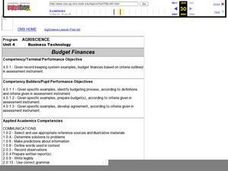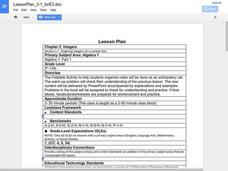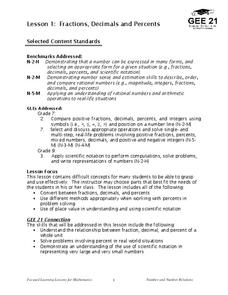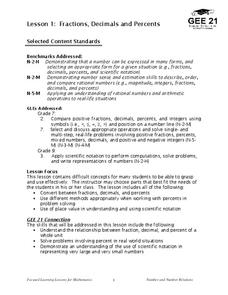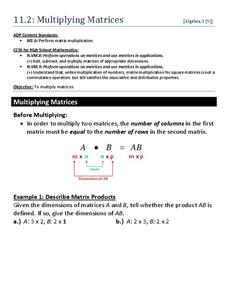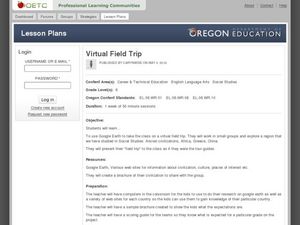Curated OER
Two Step Equations
Sixth graders solve multiple step math problems. In this problem solving lesson, 6th graders practice following step by step instructions such as making cookies or building a snowman. Students use algebra tiles and draw pictures to solve...
Curated OER
Eight Volume of a Trench Problems with Explanations and Solutions
In this volume instructional activity, students answer four multiple choice and four problems solving problems regarding the volume of a trench. Examples, formulas, explanations, and answers are provided.
Curated OER
Mr. Payne Word Search Puzzle
In this language arts worksheet, students study 10 words in a word bank, then locate them in a word search puzzle. The words appear to be related to algebra; the meaning of the title is not known. There is one misspelled word in the word...
Curated OER
The 3R's: Rights, Rules, and Responsibilities
Eighth graders complete seven work stations that highlight math activities while they focus on the rules for Internet use and classroom rules for working in cooperative groups. After completing the activities, they complete a self-...
Curated OER
Patterns
Students identify patterns in equations. In this algebra lesson, students write equations of problems with recurring patterns. They relate and model real life situation using functions.
Curated OER
Budget Finances
Young scholars role play the role of a recent graduate of high school living on their own. Using play money, they are given one month's salary and they discover they own their own house or apartment and owe money on a car loan. They...
Curated OER
Integers
Students graph integers on a number line. In this integers lesson, students create a colored foldable to assist them with notetaking and problem solving. Students complete exercises from text.
Curated OER
Integrating Functions
In this math activity, students find the answers to the functions that includes integration and trigonometry. They use the examples for help with the special functions.
Curated OER
The 4-Digit Problem
In this 4-digit problem worksheet, students use numbers 1-4, combining to create the numbers 1-100. Two examples are given at the top of the page.
Curated OER
Identify Plant Nutrient Requirements
Young scholars are given standard elemental nutrients, identify plant nutrient requirements based on criteria outlined in assessment instructment. They, are given standard elemental nutrients, provide all means and chemical symbols of...
Curated OER
Differentiate Elements, Compounds, and Mixtures
Students examine the differences between elements, compounds and mixtures. Using diagrams, they compare and contrast atoms and molecules and describe various chemical reactions. They distinguish the differences between ionic and...
Curated OER
Open Sentences
In this open sentences learning exercise, students solve and complete 10 different problems related to identifying various types of open sentences. First, they state whether each equation is true or false for the value of the variable...
Curated OER
Betrayal of Penn's Promise - The Walking Purchase
Pupils role-play the 1737 Walking Purchase. In this Pennsylvania history lesson, middle schoolers role-play the 1737 Walking Purchase and analyze its effects. Pupils also consider how it would affect their community today.
Curated OER
Patterns and Functions
Learners investigate patterns and functions. In this algebra lesson, students examine the repetition of integers and objects. They create formulas for the repetition and identify them as function using equations.
Curated OER
Mayan Math
Fifth graders investigate the Maya's as mathematicians. In this Mayan math lessons, 5th graders work with the ancient Mayan numbering system by comparing it to the American Number System. They tell the differences and similarities...
Curated OER
Students' Strides
Complete problems using base ten blocks to see the difference in the place value of a decimal and how it affects a number's value. Learners compare decimal values as well. Ample time for discussion and modeling are allowed in the...
Curated OER
Fractions, Decimals and Percents
Young scholars investigate the differences when using decimals, fractions, and percents. They focus on the process of using them in real problems and how to convert them from one form to another.
Louisiana Department of Education
Fractions, Decimals, and Percents
Fractions, decimals, and percents all say the same thing! Show your classes how to convert between the three forms using visual and numeric representations. Then lead them to an understanding of scientific notation.
Curated OER
Investigation - Dividing a Candy Bar
Fourth graders explore dividing equally. They divide three-digit divisors by one and two digit divisors. Students work real life division problems. They examine possible solutions to each problem.
Curated OER
Multiplying Matrices
Go over the basics of matrix multiplication, from checking the dimension of the factors, to applying the distributive property. This activity includes directions on when and how to multiply matrices, one example, and a few problems your...
Curated OER
Power Crisis in California
Students read an online CNNfyi.com article related to the energy crisis in California. They calculate the monthly cost of running household appliances. They develop a list of alternative methods of energy sources.
Curated OER
Virtual Field Trip
Are we there yet? Young trip planners learn about their state and plan a trip. They will select sites to see in three cities in their state, and record associated costs in a spreadsheet. While this was originally designed as a...
Curated OER
Multiplying and Dividing Decimals
Division with decimals is explained using prior knowledge of powers of 10 and how to convert both sides of a division problem using this knowledge. The class works together through reading and setting up an equation for a word problem....
Curated OER
Weaving a Story
It's time to investigate patterns! First and second graders construct a paper weaving using a hundreds chart, then use the Ti-10 calculator to make patterns such as adding 3 each time. Learners remove multiples of three from the hundreds...







